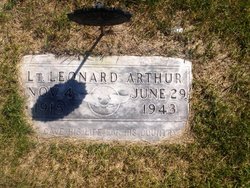
World War II
-
Fallen
Circumstances:
On June 29, 1943, four crews in the 577th Squadron were taking up brand-new Liberators on routine instrument calibration and A-5 familiarization flights. At the time, the 392nd Bomb Group was in Alamogordo, New Mexico, nearing the end of its stateside training. At about 15:47 hours, pilot 2/Lt. Leander M. Sherman in B-24E #41-28423 radioed the control tower for clearance to land. At the field, ceiling and visibility were unlimited except for a highly localized storm cell about 15 miles to the south.
With permission granted, Sherman approached Runway 3 but overshot the landing and had to go around again. As he did, the storm neared the field and the winds increased from 7 knots to 35 knots with a cross wind on Runway 3. The tower radioed #423 to advise of the wind shift and to divert to Runway 7 but couldn't make contact. Sgt. Christe G. Latsos, Jr., the Airdrome Traffic Controller on Duty, later testified that Sherman's "signals were very weak and he couldn't hear the tower very well like all the other ships could."
Sherman circled the field twice. Some witnesses thought these were actually attempts to land that were given the red flag. (S/Sgt. Staffiera, the only survivor, testified that "I knew we were circling the field the first time for a landing, but I didn't know we circled the field the second time. It was hard to tell what we were doing, the ship was rocking so much").
Soon after, Sherman tried to land on Runway 3. As he lined up, a powerful rain squall moved in and the tower lost visual contact with the ship as well. 2/Lt. David B. Spalding, the Weather Officer on duty at the time, later testified that the weather changed from "high overcast, low broken to a visibility of 100 feet, ceiling zero in a very few minutes.
With his plane rocked by extreme turbulence, 2/Lt. Sherman lost control and #423 crashed at 16:18 hours about a quarter mile northwest of Runway 25. Everyone onboard was killed except S/Sgt. Staffiera. He later said that just before the final approach, he had been sent back to the waist to make sure the landing gear was down. When the plane impacted, he was apparently thrown out the waist window. In a coma for three days, he was not expected to live and his family was summoned from New Jersey. He held on, though. After several operations and over five months in various hospitals, he was offered a medical discharge. He declined, wanting to complete his military service. He spent the rest of the war at Alamogordo in charge of the Ground Gunnery Range. He was discharged in 1946.
Out in the field chasing jackrabbits, ground crew chiefs Ernie Barber and Cleon Barber were heading in because of the rain when they heard the crash. At the site, they saw one of the pilots walking around, still strapped to his seat. As a medic approached, the man collapsed and died.
An ambulance had arrived but it couldn't get close to the site because of the flood. A doctor grabbed Perry's arm and told him to help load one of the bodies on a stretcher and bring it to the ambulance. When he finally got back to the line shack, one of the armorers was crying uncontrollably because he had convinced his close friend, Cpl. Fred Matthews, to go up for a ride that day and he had been killed.
Ten crewmembers were killed, and one survived with serious injuries.
Biography:
born Mohall, ND 4 Nov 15; resident Renville County, ND; entered AUS Monterey, CA 30 Jun 42; died in service 29 Jun 43 Alamogordo, NM; buried in Mohall Cemetery, Mohall, ND.
